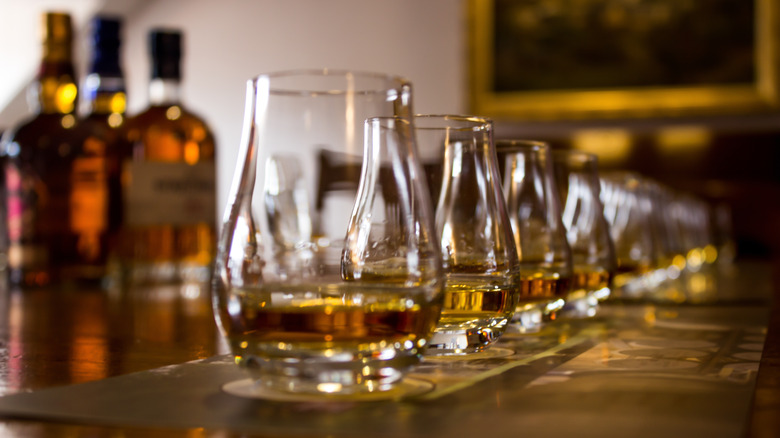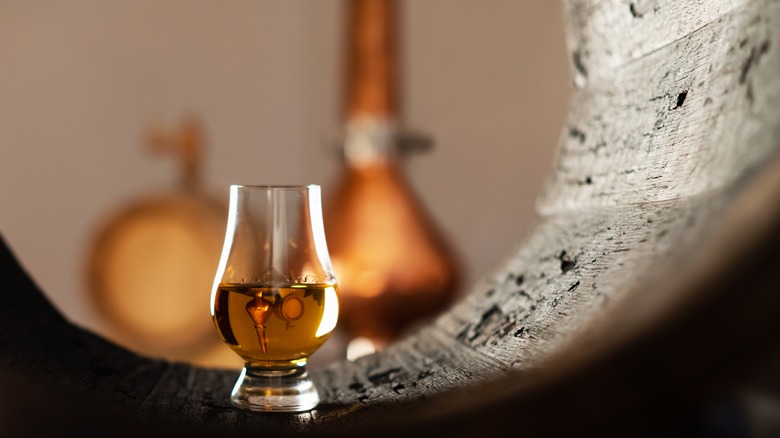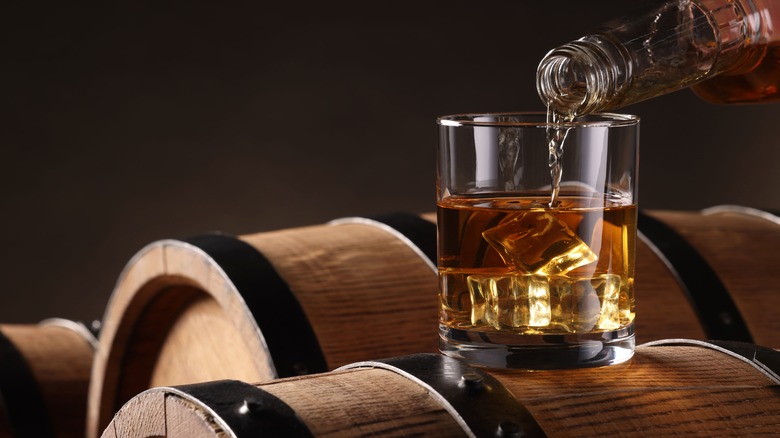The World's Strongest Whiskey Can Also Power A Sports Car
If you like to drink whiskey neat, you'll be familiar with just how strong the spirit can be, especially the higher-proof varieties. What might surprise you, though, is that it can be potent enough to power a sports car. British television presenters James May and Oz Clarke set out to demonstrate exactly how the theory works for a BBC show when they visited the Scottish island of Islay. The remote, rugged location also happens to be where you'll find the peatiest Scotch whiskies.
The premise of the pair's eccentric experiment was that whiskey is produced by distillation, and crude oil also goes through a distillation unit to create gasoline — a product which, May explains, was once known as "motor spirit" (via YouTube). Therefore, whiskey could technically be described as a biofuel, the presenter argues, since the distilled spirit is made from grain.
They used a 92% ABV liquid from the Bruichladdich distillery to fuel the car, though it's not exactly whiskey as we know it, since it was not been aged in barrels for at least three years — a legal requirement for Scotch, and what also gives whiskey its brown color. It's also not an option you'd want to consider using as fuel in your vehicle at home for many reasons, including the eye-watering expense. But it's fascinating proof (forgive the pun) of whiskey's extraordinary strength.
The distillation process gives whiskey its strength
Whiskey aficionados are often happy to wax lyrical about the spirit's power; it's not known as the "water of life" for nothing. And Scotch whisky (as opposed to whiskey) goes through several stages to become the high-proof product we recognize. It starts with malting, where the germination of barley turns to malt. Then there's mashing, where increasingly hot water is added to the dried malt. Fermentation follows, which involves adding yeast to produce alcohol — though, by this stage, the resulting liquid, which is known as wash or brewers' beer, is only about 6% to 8% ABV. It's the subsequent process of distillation, which really ramps up the potency.
Distillation turns the wash into a spirit by increasing its alcohol content to around 70% ABV, which might need to happen two or three times to get the desired product. Taking place in copper stills, it's a complex process involving heat, the separation of ethanol, evaporation, and condensation. Then the clear distilled liquid, which settles at around 63.5% ABV, is transferred to the cask to mature.
This, however, is not the final strength of the spirit. While it ages in barrels, the liquid loses a percentage of its alcohol content every year thanks to evaporation — or what is known as the angel's share of whiskey. Scotch whisky eventually tends to be bottled at a strength of around 40% to 43% ABV, though you can find higher-proof examples.
What are the strongest whiskies in the world?
Unlike regular store-bought liquor, the Scotch whisky that James May and Oz Clarke used to power a car was quadruple-distilled, giving it a much higher strength of 92% ABV – or 184 proof. The spirit, called Bruichladdich X4, managed to propel the Radical SR4 racing car to a speed of 60 miles per hour in just three-and-a-half seconds. Unsurprisingly, Bruichladdich's X4 quadrupled whisky is considered the strongest single malt in the world – though you'd struggle to buy a bottle as it's not available for sale.
While many people probably wouldn't want to drink a whiskey that can be compared to gasoline, there are still some incredibly strong whiskies on the market. As you'd imagine, they don't come cheap. They do, however, often come from Scotland's different whisky regions. Laphroaig's 10-year-old cask strength whisky, also from Islay, comes in at 57.8% ABV (or 115.6 proof). It costs $1,000 for the rare 2009 edition, which was the first year the distillery released a batch.
If you prefer bourbon, you could try Angel's Envy cask strength bourbon whiskey, which is aged for 14 extra months in port wine casks, and is similarly strong at 59.9% ABV (or 119.8 proof). However, it's only available at the distillery in Louisville, so you can't actually buy a bottle otherwise, though you can buy a less strong variation at 43.3%. We'd definitely recommend sipping it, rather than pouring it into a car.



